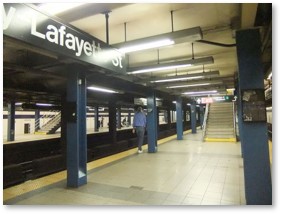I confess to being conflicted on the recent incident in New York City where a passenger on a subway train put a homeless man in a chokehold that killed him.
Now, no one, including me, wants anyone to die from a public encounter. I get that. But I also know that the homeless and mentally ill people roaming the streets of America’s cities can feel threatening and downright frightening to those around them. If you don’t understand that, you have probably never had one of these situations happen to you.
The Ghost Tour Interrupted
But one happened to me on May 9 when I was leading a Haunted Boston ghost tour for a large group of middle school kids from Canada. We started, as usual, outside the Central Burying ground on Boylston Street across from the Emerson Colonial theater.
 When I first led the group to this spot, I saw a tall thin man standing nearby and talking either to someone or himself. (It can be difficult to tell these days if someone is just on the phone with earbuds and talking to the person on the other end of the call or speaking to voices only he can hear.) I booted up my microphone and started to talk.
When I first led the group to this spot, I saw a tall thin man standing nearby and talking either to someone or himself. (It can be difficult to tell these days if someone is just on the phone with earbuds and talking to the person on the other end of the call or speaking to voices only he can hear.) I booted up my microphone and started to talk.
As I did so, he started talking louder and moving around restlessly. I employed response mechanism #1 for dealing with a delusional street person. I ignored him and continued addressing the group. The homeless man then walked out into Boylston Street traffic and accosted the drivers, who rolled up their windows and kept going. By now his shouting had become so loud that I had trouble being heard even with the microphone.
Homeless and Mentally Ill
Not, mind you, that the kids paid much attention to me. Instead, they watched him. Some had wary looks on their faces while others were laughing. I doubt they fully appreciated what they were seeing.
Increasingly concerned, I went to response mechanism #2: moving the group further away from the scene. We walked a little west on Boylston until I had put some distance between us and the man. He seemed to notice that and started toward us, seemingly with the intent to engage them or me. At that point, I considered moving to option #3: calling 911.
Keep in mind that I’m a tour guide, not a social worker. My job is to lead a tour of Boston for people who have paid for it. In this case, they were school kids and they were my responsibility. Yes, a chaperone accompanied the kids and he was male. Still, I did not really know what I would do if the homeless man became aggressive.
I also felt uncomfortable with taking time away from my job to report the man’s erratic behavior. And I feared that he would notice what I was doing, feel threatened, and become more aggressive toward me.
Fortunately, the situation did not escalate to that. Distracted by something, he wandered away toward Tremont Street and I was able to focus on my tour. Crisis averted.
Not Trained for This
In the 10 years I have been a tour guide for three organizations, I have never experienced such a situation. We are trained to deal with detours, loud noises, questions, argumentative guests, bad traffic, and distractions. At no point did I learn what to do when an aggressive, mentally ill person interfered with my tour. Keep in mind that I am a grandmother of average size. I could see no upside in a physical confrontation with a large and aggressive man.
Once, I left a bandage and an antiseptic wipe for a homeless man who had a bleeding wound on his knee. Another time I gave some money to a homeless man and warned him to seek shelter because it was going to be a very cold night. I have walked past groups of homeless people chatting among themselves and sometimes had to ignore their gratuitous comments.
But those incidents were not direct interactions and they were not personally threatening in the way this situation felt. What was my duty as a citizen? What was my duty as a tour guide? Should I have called 911? How could I know whether he needed an intervention? Was I my brother’s keeper? Or would it have been more dangerous to intervene? Would I have been putting those kids at risk? Does anyone know?
The New York Situation
 That’s why the New York confrontation confuses me. I can understand the fear of being trapped in a subway car with a delusional person. Even if he’s not threating you directly, he is unpredictable and you just don’t know what he’s going to do next. I feel for those passengers and I don’t think the press is addressing that aspect of the case seriously.
That’s why the New York confrontation confuses me. I can understand the fear of being trapped in a subway car with a delusional person. Even if he’s not threating you directly, he is unpredictable and you just don’t know what he’s going to do next. I feel for those passengers and I don’t think the press is addressing that aspect of the case seriously.
We put our mentally ill people out on the street in the sixties and things have only gotten worse since then. Unhoused, unmedicated and often unwanted, the mentally ill roam our streets without supervision or guidance. None of us outside the mental health system know how to deal with them except as fellow human beings.
STATISTICS AND THE MOMENT
I understand what the statistics say about the mentally ill not being violent but how could I know what his voices were telling him? How did the man who restrained Jordan Neely on a subway car know that? He also could not have known that Mr. Neely had been arrested more than 40 times, including for violent behavior. Mr. Neely also had been committed for psychiatric evaluation or treatment, both voluntarily and involuntarily, on numerous occasions. Does that mean he could be ignored safely?
As I said, I am conflicted. How do you feel about it?
EDITORIAL NOTE: For the people who have responded to say, “What was the big problem? Nothing happened.” Yes, that’s true. My situation had the best possible outcome from my perspective. But in the moment I did not know that would be the case. I didn’t know the man would just wander off. (Nor do I know what happened after that or if he accosted others.) The people on that train didn’t know what Jordan Neely would do, either.
I have lived in New York City and I have been in the Lafayette Station many times. NYC has some pretty scary people and I can’t think the folks on that train just blew off Mr. Neely’s rant as only words. My point is: when it’s happening just don’t know how it will end.

I’ve been in public places with people that are out of control and you do not know how it will end. Had to ask a man to tell a vety aggressive mentally ill person to stop bothering a young teenager (maybe 15) who was just waiting for his bus. I was worried the person I asked would go overboard (he didn’t) but I had no choice but to help this young teenager. I’m a short woman and I had already felt threatened by what the man was saying to me. So unfair that I and everyone else don’t get to commute in peace. The story in NY is heartbreaking.